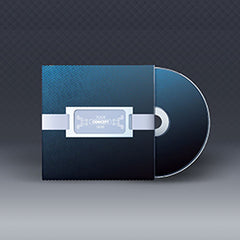
First impressions are important and that’s why you want to have the best CD packaging representing your work. Introduced in 1982, the compact disc (CD) provided better sound quality than vinyl records or cassettes, while offering more room for storage. And although CDs are more durable than their predecessors, these thin discs still require protective covers. There are many things to consider before you select the CD packaging for your project. The product, audience, branding, and budgeting all play a role. From economical to eye-catching, here are some of the most frequently used styles and the advantages and disadvantages of each.
Sleeves
On a budget, but need something professional? Sleek, space saving, and economical, a paper or card sleeve is a small square that opens on the top or side (think mini album cover). Some have a clear plastic window so you can see what’s inside. The compact disc stays put within the sleeve thanks to the snug envelope-like design. It’s commonly used for promotions, singles, or demos since it isn’t substantial enough for entire albums and doesn’t provide the quality required for premium pricing. Plus, the thin, lightweight, and inexpensive design makes it ideal for mail slots, handouts, and giveaways.
A step up from the paper sleeve is the cardboard wallet. More professional in appearance, it often has a spine, which makes it ideal for displaying on shelves.
Jewel Cases
Most people think immediately of the jewel case when they are considering CD packaging. These plastic cases include a tray inside to hold the CD in place and have room for paper inserts or booklets with print or artwork. A cogged hub inside holds the CD in place. This well-known option is definitely economical and versatile, but the brittle plastic construction is susceptible to cracking. The hinges that hold the two halves together weaken with overuse.
The good news is that these traditional cases are getting upgraded with stronger plastics and rounded corners. Although the newer ones are more durable, they are also more expensive and are not used for smaller duplication amounts.
There are also many variations on the jewel case. A slimline is half as thick as jewel case, making it a good choice for mailing. A slim double holds a CD on each side, while a multi case, or fat case, allows for more than one disc, plus more places for art, lyrics, credits, etc.
Plastic Sleeves
Plastic cases are often bought separately and are designed for protection. Made of soft clear plastic, a PVC wallet is probably the cheapest form, but offers less protection than its rigid cousin, the clam shell case. This durable case has a space-saving design that resembles the shape of its namesake.
Paper or Plastic? How About Both!
Going on tour? Take along the digipak. Attractive, lightweight, and durable, the digipak is similar to a jewel case, but consists of folded cardboard with a plastic tray inside. Cover art is printed directly on the cardboard, which opens like a book to reveal a disc mounted securely on a tray. This more recent design has gained popularity over the jewel case because it combines plastic and cardboard to create a strong yet stylish package. Expanded versions with additional panels provide more room for artwork and print content. Booklets and inserts fit neatly inside.
Need Help Choosing Your CD Packaging?
The types of CD packaging listed above are typical styles that take into consideration visual appeal, protection, and budget. Of course, there are many more types available and it’s possible to get a custom-made case. With so many options to choose from it’s best to consult an expert. We help musicians, entrepreneurs, small businesses, and large corporations deliver their content with high-quality products and outstanding service. Call Disc Hounds at 610-696-8668 and let us help you decide what works best for your project.

